Volume hiring is different from regular recruitment. When you’re hiring at scale, regular recruitment tools simply won’t cut it – it’s like using right-handed tools when you’re left-handed.
It can work, but it’s more troublesome, time-consuming, and unnatural.
Volume hiring requires software that’s built to handle volume: technology that’s purposely built to take your hiring strategy from where it is today to where it can and should be in the future.
At Harver, we’re building software with the specific challenges of volume hiring in mind. Our vision is to enable companies to hire faster, better, and in a fundamentally fair way.
In practice, this means that we’re not limiting our solution to a set of features and capabilities meant to solve the challenges that you – an employer in the volume hiring space – are facing today.
Instead, we’re designing a solution that enables you to streamline and dynamically scale your hiring efforts as candidate volume fluctuates, without increasing your recruiter headcount or adding more tools to your hiring tech stack.
Because we’re laser-focused on building for volume, we have a strong opinion on what a volume recruitment platform should and shouldn’t do. Here’s our point of view.
What’s in?
Like what you see?
Don’t miss out. Subscribe to our quarterly digest to get the latest TA and TM resources delivered right to your inbox.
What volume hiring software should do for you
Let’s start with the big picture: the purpose of a volume hiring solution is to help you hire the right candidates at the end of a recruitment process that’s efficient and enjoyable for both the candidate and the recruiter.
On top of this, a volume hiring tool needs to give your TA team visibility into your recruitment data – candidate data and operational data – so that you can easily spot patterns and identify weak points.
If we break this big picture into smaller pieces, we understand that the most important elements of a volume hiring strategy, and the components that need to work perfectly in a volume hiring tool, are:
- The candidate selection process
- The application process itself, or the recruitment journey, which has a candidate-facing component and a recruiter-facing component
- The recruitment data collection and processing
For this reason, the volume hiring solution that we’re developing at Harver incorporates the following building blocks:
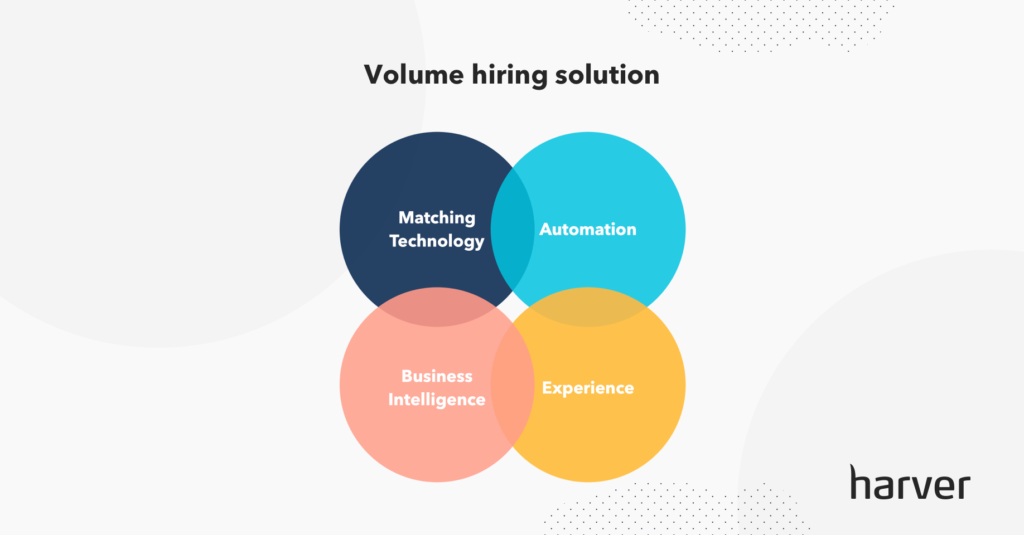
The matching technology is used behind the scenes to help companies identify the applicants who have the right skills and characteristics, fit the culture, and are available to fill the open roles.
The candidate experience piece ensures that applicants go through an engaging experience and receive enough information about the role and company to manage their expectations and prevent early attrition.
Next comes the automation part, which ensures that all the processes that don’t require real-time human input are automated and streamlined. This makes it easy to scale operations up or down in case of changes in the labor market or in demand on your side.
Finally, the business intelligence piece ensures that you have the right data and insights to make informed decisions: you know what skills candidates have and whether those skills are good predictors of future success in your organization, and you know how your recruitment team is performing. You can see which stages of your recruitment process are and aren’t working, and you can make data-driven decisions to optimize your talent acquisition and management strategy.
Now that these blocks are clear, let’s look at some specific characteristics of volume hiring platforms.
1. Hire the right candidates, at scale
For entry-level roles, applicants are looking for job security, fast; they want a quick selection process that gives them a job and a paycheck, now. But when you’re volume hiring, you’re dealing with hundreds, if not thousands of applications that all need to be screened and assessed equally and fairly. This is an impossible task for recruiters to do manually at scale.
Unbiased candidate selection tools allow you to hire for skills, not based on a gut instinct. For example, situational judgment tests (SJTs) are a popular behavioral assessment tool that provides applicants with a realistic job preview, while you assess their skills and abilities, gauging their reactions to determine how suitable their behavior is for your open role and your company in general.
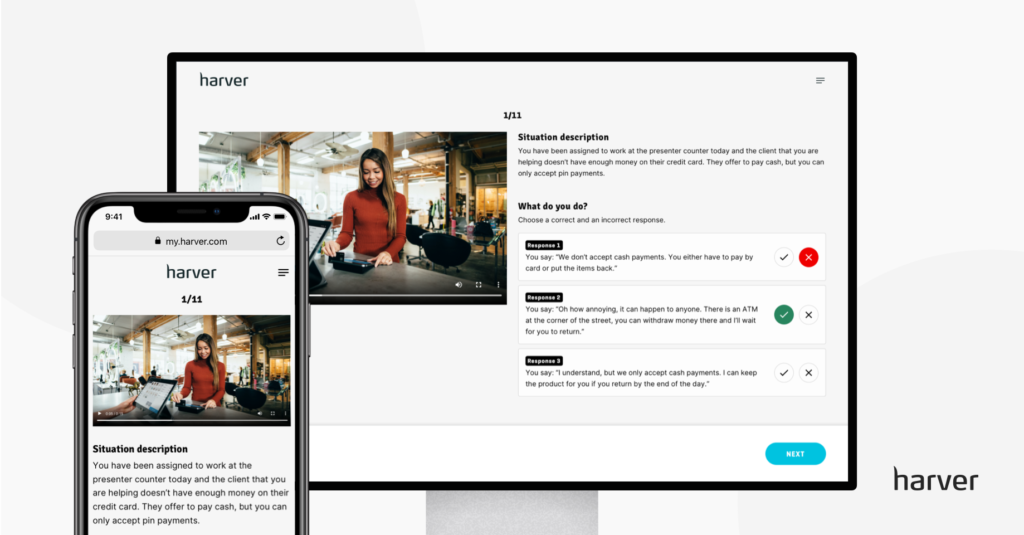
No matter the organization or role, there are always skills and competencies that predict success on the job. To hire at scale, you should be systematically screening candidates for the characteristics that predict success in your specific organization.
Matching technology is built exactly for this purpose: to help you evaluate candidates at scale, across multiple competencies that are relevant for your open roles and predictive of success on the job.
Matching technology does the hard work for you by assessing candidates, scoring their skills and competencies, and moving applicants forward in the recruitment process if they meet specific selection criteria. This helps recruiters make objective, data-driven decisions about candidates while ensuring a high quality of hire.
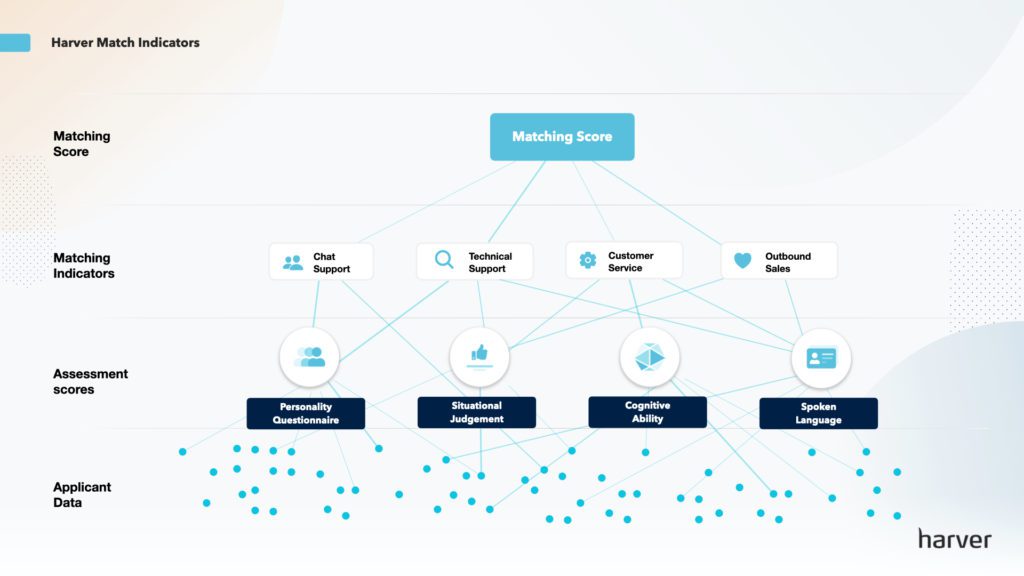
The details of matching technology implementation might vary from one organization to another, in the sense that each position or job family might require custom, role-specific assessments that measure not only a set of hard and soft skills, but also a candidate’s organizational fit.
But in general, talent matching technology relies on pre-employment assessments used to identify candidates with the skills and disposition to be a top performer in a specific role.
2. Optimized talent pool
When hiring at scale for multiple locations, you want to enable candidates to apply to all locations in one go. If one of your locations has challenges hiring, whereas other locations have too many applicants, you need a platform that offers candidate routing capabilities.
Rerouting candidates within your organization is a no-brainer – it ensures you optimize your talent pool, keeping strong candidates within your organization, while offering them opportunities they may not have realized they were capable of.
We’ve explored this topic in the webinar below.
3. Interview scheduling on autopilot
Interview self-scheduling capability allows candidates to move quickly through the recruitment process, ensuring time to commitment is short.
When you’re recruiting low numbers, manually scheduling interviews is an annoying task; when you’re volume hiring, it’s impossible. You need a volume hiring solution that reduces manual work, while scheduling multiple candidates for an interview at once.
Even more than that, you want candidates to be able to schedule an interview for more than one role at a time if they’ve applied for multiple roles at your organization, or for the same role at different locations. And many platforms can’t offer that functionality.
Ready to transform your hiring process?
4. Synchronicity across calendars
Your high-volume hiring tool needs to synchronize across all your recruiters’ calendars, to keep the process streamlined and efficient. There is no point allowing candidates to self-schedule interviews only for recruiters’ calendars not to sync and have everyone out of kilter.
However, many interview scheduling tools are unable to synchronize recruiters’ calendars with one another, or with the ATS, meaning TA leaders don’t have oversight of upcoming interviews. This creates more work because they have to manually check in with other recruiters, or switch between tools to get the information they need.
5. End-to-end streamlined process
From candidate sourcing to interview scheduling, you want your chosen volume hiring platform to facilitate an end-to-end streamlined process.
Recruitment automation speeds up your workflow and frees recruiters from manual tasks by quickly moving top candidates through your hiring process while rejecting those that are a poor fit. A faster workflow means fewer lost candidates and lower hiring costs, so you increase the likelihood of employing top-quality talent while keeping operation costs low.
The level and depth of automation varies depending on your organization’s needs — encompassing as much as the entire process from “apply” to “hire” or combinations of steps in between. In an ideal reality, after candidates apply, screening and selection are automatic and the candidate details are sent to the ATS.
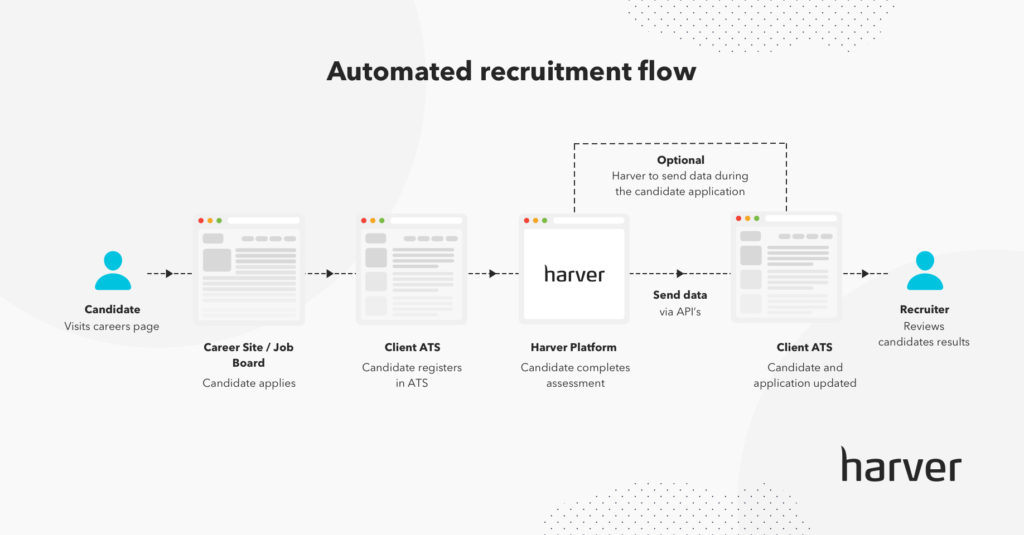
If candidates are auto-matched accurately, it means you can also automate the interview scheduling step, if you have an interview in your recruitment process.
Candidate results in the Harver platform, for example, are instantaneously calculated, meaning that as soon as a candidate has completed the application, they have the option to self-schedule an interview if they meet the criteria. This eliminates the entire callback period, where candidates are left waiting after hitting apply or handing in a resume.
Automation can also be used to route applicants between locations. Our platform calculates where candidates are most likely to get hired, based on the availability of open roles and applicants. Recruiters are then able to see in real-time who fits the role based on their assessment results, and when they’ll be coming in to interview if self-scheduling is enabled.
This enables our clients to hire candidates within 24 hours, instead of several days. Thus, automation can be used to remove process inefficiencies.
6. Centralized process
When recruitment is decentralized to individual stores, restaurants, or call centers, it becomes the managers’ responsibility to recruit new employees. Not only does this lead to HQ having no insight into how they’re making hiring decisions, but when managers are already busy in their day jobs, candidates are left hanging around.
You want one command and control center for all your TA and recruitment teams, so that everyone works with the same data, in the same way – everyone has the same big picture/overview, etc. Everyone recruits via the same process, aligning all your hundreds or thousands of location managers, without taking away their final hiring decision.
7. Data collection and visualization
To navigate the complex world of high-volume hiring, you need insights into your recruitment metrics and performance. These can be delivered through high-end business intelligence tools. Your volume hiring platform should collect all of the relevant data you need to make data-driven hiring decisions and eliminate unconscious bias.
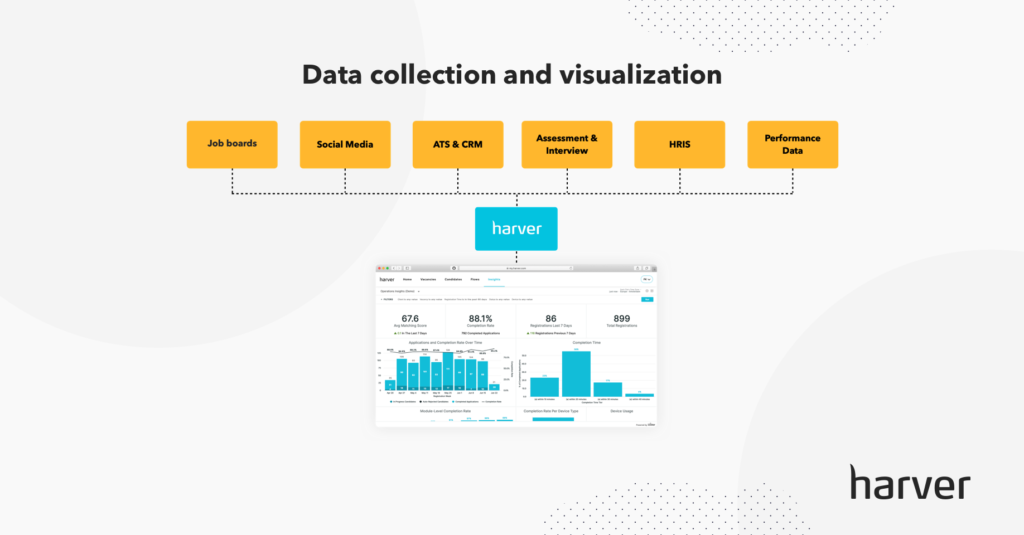
Harver, for example, offers real-time data through a series of out-of-the-box dashboards, but you can create your own reports as well if you want to track specific KPIs. One dashboard shows you candidate experience scores, such as how satisfied they were with the application; another report gives you insights into the matching scores of your candidates, enabling you to easily see who’s a good fit for the open roles.
Then we have the sourcing insights; when you work in high volume, you need to know what source gives you the best candidates, where your top performers are coming from. Finally, the D&I dashboard makes it easy to track DEI metrics and identify bias present across locations and recruitment funnel stages, helping your company follow through with your diversity and inclusion program.
Our BI solution is therefore suitable not only for interpreting candidate scores but also for optimizing your sourcing strategy to decrease your cost per hire and improve the quality of hire in the long run.
8. Integration with existing tech stack
You want your chosen high-volume hiring tool to seamlessly integrate with your existing recruitment tech stack, your ATS for example. Your ATS is the technology backbone of your recruitment process, it’s essential that these two are compatible.
But it’s not just ATS that you want your volume hiring software to integrate with. If you rely on multiple tech solutions, you want it to work with all of them when you’re:
- Sourcing top candidates at volume with programmatic job advertising software.
- Convincing qualified visitors to apply to your role with smart recruitment marketing software.
- Tracking your efforts with website analytics.
- Retargeting qualified potential candidates who didn’t initially apply.
- Selecting the right candidates to take forward with candidate selection software.
- Sifting resumes with CV screening software.
- Carrying out pre-selection with scientifically validated pre-employment assessments to see what types of roles candidates might be successful at.
- Video interviewing – either live or with pre-recorded video
- Making a hiring decision at scale, without bias or prejudice clouding your choice.
- Onboarding successful candidates.
Harver connects to the tools you use everyday, providing a seamless experience for both recruiters and candidates alike. It literally supercharges your existing tech stack, acting as an intelligence layer that enhances what you’ve already got in place.
If you’d like to see how Haver can transform your hiring process,
book a demo here!
9. Customizable and brandable experience
Off-the-shelf options might appeal because they’re cheaper, but they likely only offer basic functions. However every organization is different, with different volume hiring needs, requiring unique recruitment solutions.
A customizable volume hiring platform, such as Harver, will integrate with your existing software, providing assistance where you need it, not just where it’s offered. It provides modularity and the ability to build custom candidate selection flows based on your open roles and the state of the labor market – depending on whether it’s tight or slack.
When you’re volume hiring, you’re competing against companies who offer similar salaries and benefits – anything you can do to stand out, even just displaying your branding on every page, could make all the difference.
Your recruitment process should be an extension of your company. It should reflect the company culture, to make sure you’re attracting candidates who fit your culture and won’t end up leaving in the first months after being hired.
The recruitment process isn’t separate to how the rest of the company operates, you’re giving applicants who know very little of your internal workings a glimpse behind the curtains, to see whether they like what they see before they commit to come and work with you. That might sound counterintuitive, giving applicants the option to opt out, but do you really want to waste time and money recruiting someone who is going to quit soon after starting? If they even start at all?
Plus, branding every step of your recruitment process keeps your brand at the front of their mind throughout their candidate journey with you.
10. Flexiblity and ease of use
A volume hiring platform should be easy to use and intuitive, providing good UX and interactivity – the recruiting experience should be pleasant for both candidates and recruiters.
Look for flexibility to create custom candidate experiences that sell the job while helping you filter the right candidates. With volume hiring, you want to have some drop-off in the funnel, because you want to attract only candidates who will be top performers.
You need your high-volume hiring tool to be flexible, allowing you to test as many different approaches as needed to attract as many high-quality applications as you can for your low complexity roles, repeatedly. Because what works for one campaign might not work for another.
What worked during a tight labor market is unlikely to yield the same results in a slack labor market. Invest in high-volume hiring software that affords you the flexibility to hire, constantly.
Next steps
Regardless of what your volume hiring strategy looks like at the moment, if you want to build a future-proof recruiting machine, you need to embrace techology and move away from outdated processes and practices.
Also, you need to have a clear vision of where you’re now and where you want to go: how the ideal picture looks for both your talent team and your candidates. Once you know what your vision is, you can choose a volume hiring solution that helps you bring that vision to life.
Ready to transform your hiring process?




